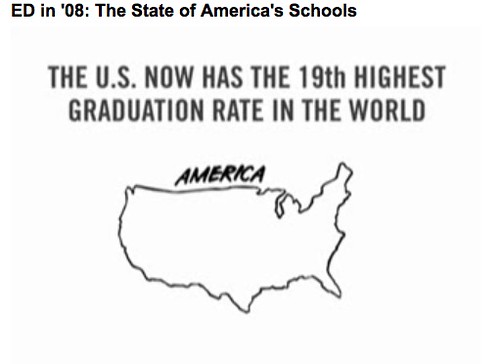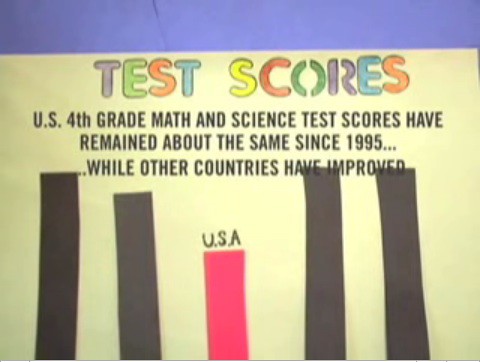from
Measuring Up: What Educational Testing Really Tells Us by Daniel Koretz --
...these critics usually miss the flip side of the coin: ignoring noneducational causes of variations in scores--that is, assuming that scores are a direct indication of school quality--lets some high-scoring schools off the hook. Some schools have high test scores because of the students they serve rather than the quality of the education they offer, but those who are convinced that scores most reflect educational quality consider them good schools regardless. My own children attended some of the highest-scoring schools in our state. They did indeed have some truly superb teachers, but they also had some mediocre ones and a few I thought should not have been allowed to teach at all, including one English teacher whose grammatical and vocabulary errors during parents' visiting day were so egregious that they sparked repeated and audible protests from the parents sitting in the back of the room. Test scores were nevertheless always high, a reflection in part of the very high education level in the community, which was full of attorneys, physicians, academics, economists, foreign diplomats, biomedical researchers, and the like...Not only did these parents provide--on average--environments highly conducive to academic achievement, but many also provided supplementary instruction, either by reteaching material themselves or by paying for the services of neighborhood tutoring firms.
A concrete example: when my son was in seventh grade, took a math class that was not well taught. (I went and watched, to confirm my hunch.) One evening he told me that he was confused by his math homework, which was part of an introduction to probability and statistics. I first tried to clarify the homework, but I soon realized that he was missing a few key notions. I asked him for his class materials, looked them over, and retaught him some of the core concepts, and after that he was able to handle the homework. I went back to the kitchen to clean up from dinner, but he soon called me upstairs again. He had just auditioned successfully for the school's jazz band, and he was having trouble counting out rhythms in the piece he was supposed to practice. I counted them out for him, but he still found them confusing (as I had too, many years earlier, when I first tried playing jazz). So I fetched my own horn and played the music at about half tempo while he counted it out. That worked. As I resumed scrubbing pots, my wife turned to me and said, "There you have it: social class differences in educational achievement."
[snip]
Disappointing scores can mask good instruction, and high scores can hide problems that need to be addressed.
p. 119-120
There is a phenomenal amount of tutoring going on in affluent school districts.
Phenomenal. One of the tutors working in my town told a friend of mine that she estimates half of the kids in Scarsdale are tutored.
I believe it. When I met with the assistant admissions director at one of the local private schools, she told me she had been a Scarsdale tutor for several years. She along with many others.
I've come to think it was inevitable that matters would develop in this way.
First of all,
public schools are built to provide inputs, not outputs: instruction, not achievement.
That may not have been so deadly when schools grouped kids homogeneously. With homogeneous grouping the classroom teacher probably had a decent chance of knowing where the kids were and of being able to teach to their level.
Along comes the de-tracking movement, and now you've got heterogeneously grouped classrooms with kids all over the map in terms of readiness. The inputs model hasn't changed, so teachers are told to teach to the middle, or they're told to
differentiate instruction, and when teaching to the middle or differentiating instruction work for some of the kids but not all of the kids, you assume
the problem is the kid, not the school. After all, the school's job is to provide
opportunities to learn, and as long as you've put PowerPoints on the SMARTBoard, you've done that.
Then add to this set-up school districts in which the vast majority of parents are college-educated and affluent enough to hire tutors, and what do you get?
You get "high-performing" schools where the kids are being retaught by parents and tutored by tutors.
can a parent sue for educational malpractice?
Galen Alessi's "Diagnosis Diagnosed"







